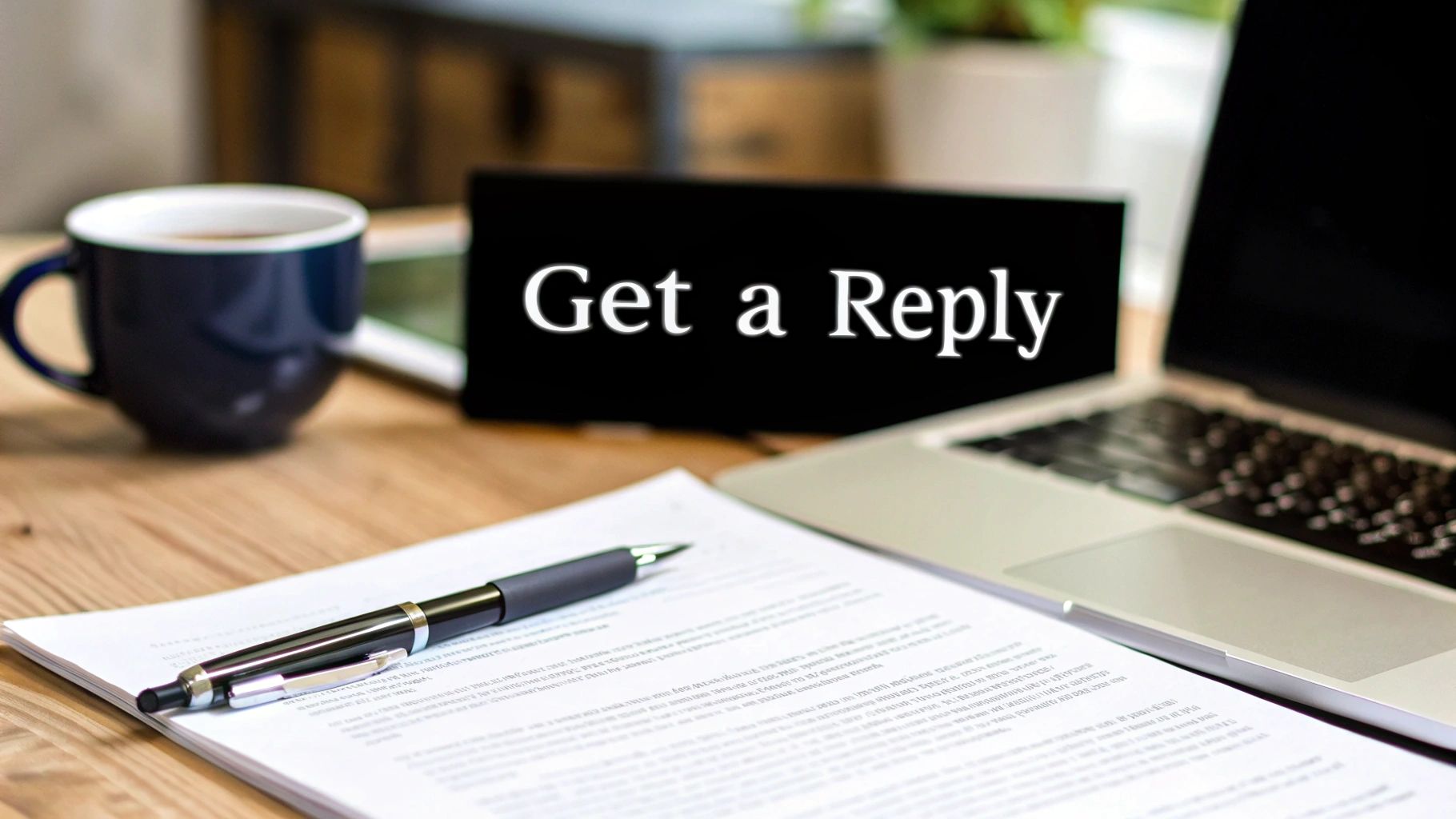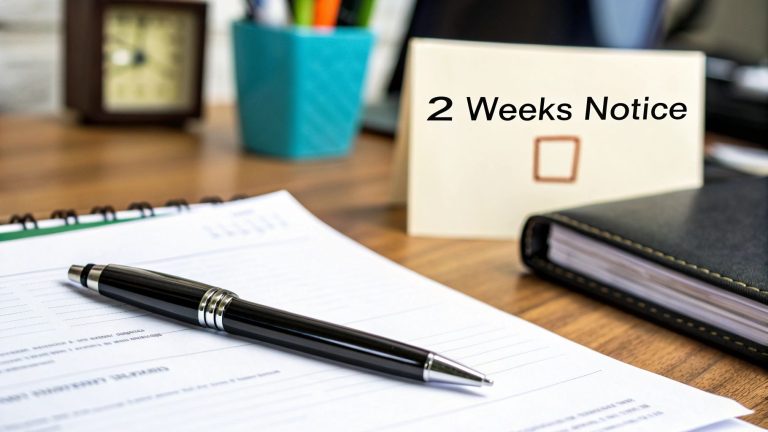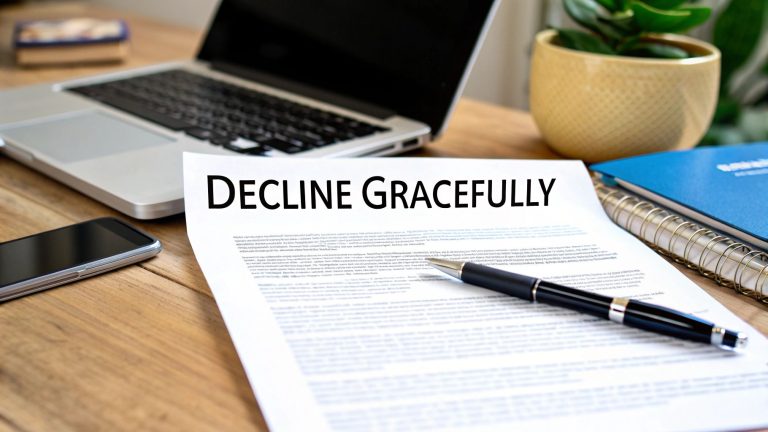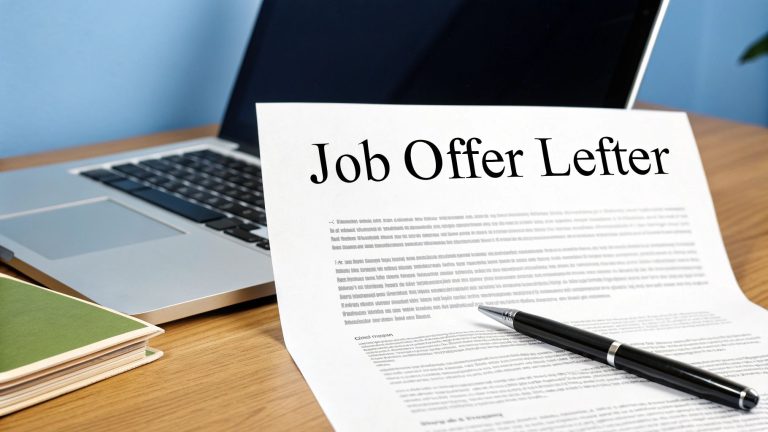An inquiry letter is your way of knocking on a company's door before they even know they need someone. You’re not just responding to an ad; you’re proactively reaching out to explore potential opportunities, ask for information, or see if they’re interested in a project you have in mind. It's a strategic move that shows you're a motivated professional who starts conversations, not just waits for them.
What an Inquiry Letter Actually Does for You

Before you start writing, get this straight: an inquiry letter is a tool for creating opportunities from scratch. Think of it as your professional icebreaker for situations where there’s no "help wanted" sign hanging in the window.
Unlike a cover letter, which is always a direct response to a specific job opening, an inquiry letter is all about initiative. It’s you reaching out because you genuinely admire the organization’s work, believe in their mission, or see a way you could contribute.
Inquiry Letter vs. Cover Letter
People often mix these two up, but their timing and purpose are completely different. A cover letter essentially says, "I'm the right person for the job you advertised." An inquiry letter, on the other hand, says, "I believe I can bring real value to your team, and I'd love to talk about how."
It's a small distinction that changes everything. You’re not just another applicant in a pile of resumes. You're creating a unique space for yourself. Getting this proactive approach right is a huge part of effective professional letter writing.
To make it even clearer, here's a quick breakdown of how they stack up.
Inquiry Letter vs Cover Letter Key Differences
| Attribute | Inquiry Letter | Cover Letter |
|---|---|---|
| Timing | Sent proactively, when no job is advertised. | Sent in response to a specific job posting. |
| Purpose | To explore potential opportunities, gather info, or start a dialogue. | To apply for an advertised role. |
| Focus | Highlights your potential value and interest in the company itself. | Tailored to the requirements listed in the job description. |
| Call to Action | Asks for an informational meeting, a brief chat, or guidance. | Directly asks for an interview for the specific position. |
This table shows that while both letters showcase your skills, the inquiry letter is about creating an opportunity, whereas the cover letter is about seizing one that already exists.
The real goal isn't just to ask for something. It's to start a meaningful conversation. A brilliant inquiry letter makes the recipient feel like they've just discovered a valuable new contact, not like they've just been handed another request.
Common Scenarios for Inquiry Letters
This proactive tool is surprisingly versatile and goes way beyond just job hunting. Here are a few real-world situations where knowing how to write a sharp inquiry letter can make all the difference:
-
Exploring Unadvertised Jobs: You've been following a company for a while and love their culture and recent projects. You can write directly to a department head to introduce yourself and ask about potential future openings. This puts you on their radar long before a role ever goes public.
-
Securing Grant Funding: Many philanthropic foundations actually prefer (or even require) a brief letter of inquiry before you spend weeks on a full proposal. This saves everyone time by making sure your project aligns with their funding priorities from the get-go. In fact, over 90% of foundations in the U.S. use this initial step to screen applicants.
-
Requesting Information: If you're an academic, researcher, or journalist, these letters are perfect for requesting access to archives, specific data, or an expert's time for an interview. It's a way to establish your credibility and purpose right from the start.
Do Your Homework Before You Write
A truly great inquiry letter feels personal because it’s built on solid research. Honestly, sending a generic, mass-produced email is the quickest way to get ignored. A personalized letter, on the other hand, immediately shows you have a genuine interest and that you respect the other person's time.
The real goal here is to move beyond a quick glance at the company’s homepage and find a real, human connection. That means digging into the details that reveal what the organization is focused on right now—their priorities, challenges, and recent wins. When you know what they’re excited about, your letter can speak directly to that.
Pinpoint the Right Person
First things first: you need to figure out exactly who should get your letter. Sending an inquiry addressed "To Whom It May Concern" is a guaranteed one-way ticket to the trash folder. You need a name, a title, and a clear idea of what that person actually does.
LinkedIn is your best friend for this. Look for department heads, hiring managers, or project leads in the specific area you're interested in. For example, if you’re a software developer, the VP of Engineering or a specific Product Manager is a much better bet than the general HR inbox. Mastering a few search tricks can make a huge difference, and something like a Boolean search can help you identify target profiles with surprising accuracy.
Find Your Authentic Connection Point
Once you have a name, your next job is to find a genuine reason to reach out. This is what separates a thoughtful inquiry from spam. Your research should uncover specific, timely information you can reference.
Look for little details that prove you’ve done more than just scratch the surface. Good places to look include:
- Recent Press Releases: Did the company just launch a new product or announce a big partnership? Mentioning this shows you’re paying attention.
- Industry News: Has the organization been featured in a trade publication for an innovative project? That's a perfect opening to show you admire their work.
- LinkedIn Activity: Check your contact's profile. Did they recently publish an article or share a post about a topic you’re passionate about? This creates an immediate, personal link.
This visual gives you a good idea of how to gather intel before you even think about writing.
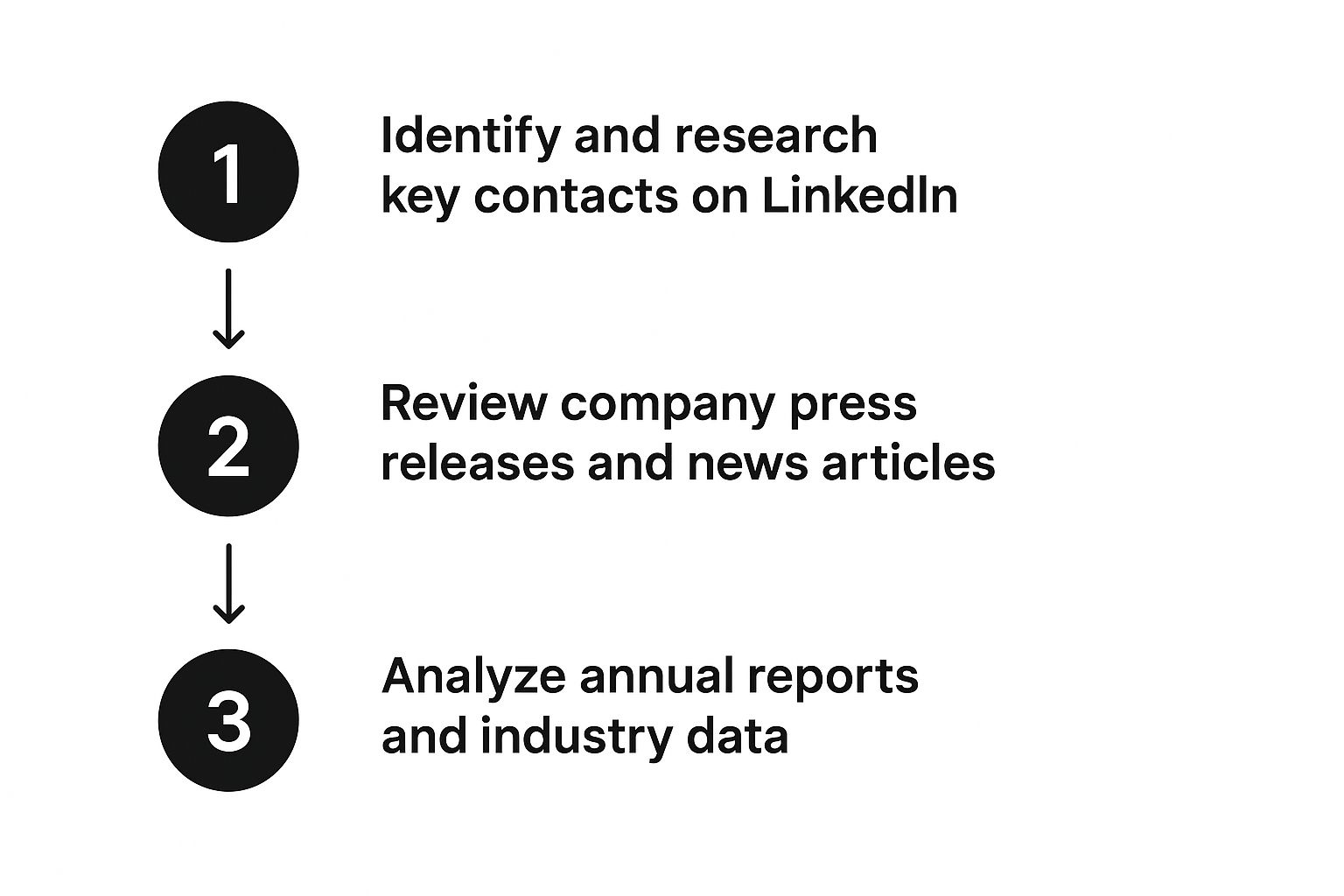
This process isn't just about finding a name; it’s about understanding their world so you can craft a message that actually resonates.
The key is to connect what you found to you. Don't just say, "I saw you launched Project X." Instead, try something like, "I was fascinated by the launch of Project X, especially since my own expertise in sustainable materials directly aligns with its goals."
This single shift in your approach transforms your inquiry from a simple request into the beginning of a conversation. It proves you’ve invested time and are genuinely interested in their work, not just any old job. That small effort makes all the difference.
How to Structure Your Letter for Real Impact
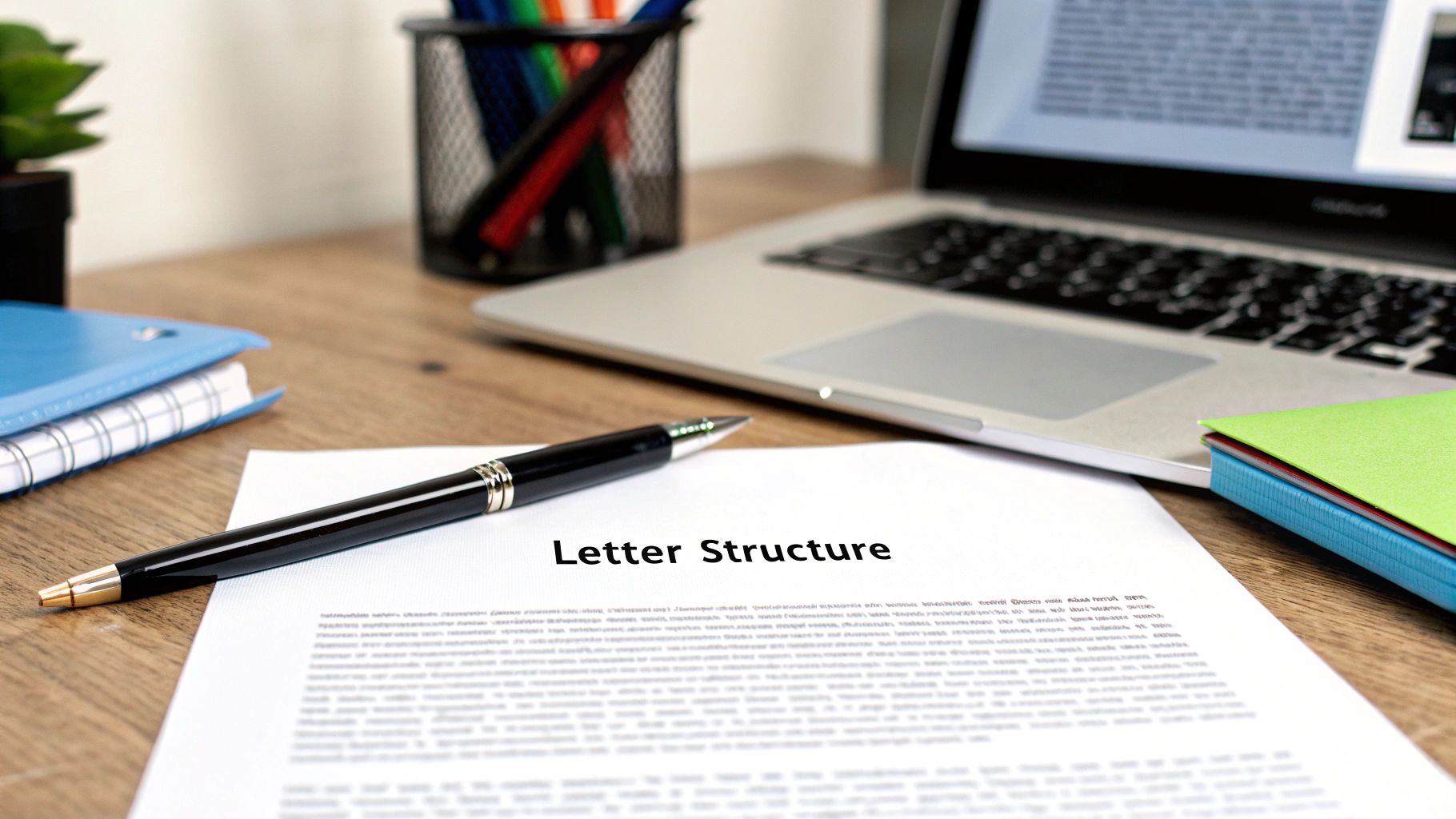
Let's walk through the anatomy of an inquiry letter that actually gets read. This isn't about following a rigid template; it's about understanding what each part of the letter does, so you can build a message that flows naturally and persuasively.
When you nail the structure, you make it incredibly easy for the reader to understand what you want and how to respond.
Your Subject Line Is Everything
Think of your subject line as the gatekeeper. It’s your first—and sometimes only—chance to make a good impression. If it's vague, your email is destined for the trash folder.
Generic lines like "Question" or "Introduction" just don't cut it. They’re easily ignored because they don't signal any value.
Instead, get specific and show you've put some thought into it. Here are a few approaches that work:
- Direct and Informative: "Inquiry Regarding Potential Marketing Roles"
- Referral-Based: "Referred by Jane Doe // Inquiry about UX Design"
- Topic-Focused: "Inquiry: Experienced Supply Chain Analyst"
A great subject line gives the recipient a clear reason to open your message. It respects their time and sets a professional tone right from the get-go.
The Opening Hook
Once they've opened your email, the first sentence is your next hurdle. Skip the generic pleasantries and get straight to it. Your opening needs to do two things instantly: identify yourself and state your purpose.
Don't bury the lead. A confident and direct opening works wonders.
For example: "My name is Alex Rivera, a data scientist with a background in logistics, and I'm writing to inquire about potential opportunities with your analytics team." This tells the reader exactly who you are and why you're in their inbox—no guesswork required.
This immediate clarity shows you're confident and makes it easy for the recipient to know what to do with your email.
The best inquiry letters feel like a conversation starter, not a demand. Your structure should guide the reader gently from "Who is this?" to "This is interesting" and finally to "I should respond."
The Body and The Ask
This is where your research really pays off. In one or two short paragraphs, you need to connect the dots between your skills and their company's needs.
Explain why you are contacting them specifically. Maybe you can mention a recent project they launched, a company value that resonates with you, or an industry trend where your expertise could be valuable.
Then comes your "ask." Be completely clear about what you want. Are you hoping for a brief informational chat? Inquiring about unlisted job openings?
State it plainly. For instance: "I would appreciate the opportunity for a brief 15-minute call next week to discuss how my skills in Python and machine learning could support your team's upcoming initiatives."
The Professional Close
Finally, wrap it up with a professional closing and a simple call to action. Keep it clean and direct. A simple "Sincerely" or "Best regards," followed by your name and contact details, is all you need. Knowing how to end properly is a crucial part of learning how to format a letter the right way.
Make sure your email signature is complete with your full name, phone number, and a link to your LinkedIn profile or professional portfolio. This makes it effortless for them to learn more about you with a single click.
Finding the Right Tone and Voice

You can have the most perfectly structured letter in the world, but if the tone is off, it’s going to fall flat. Your tone is the personality of your message; it’s what makes the reader feel seen and respected, not annoyed or put off. Getting this right means walking a fine line between confidence and humility.
You're aiming to sound like a capable professional, not an arrogant know-it-all. But you also want to show genuine interest in the company without sounding like you’re desperate for any old job. Nailing this balance is everything when it comes to making a great first impression.
Write with Confident and Positive Language
One of the easiest ways to get your tone right is to use active, positive language. Writing in an active voice makes your words feel more direct and energetic, which naturally comes across as more confident. For example, instead of a passive phrase like, "Your company's latest project was found to be impressive by me," just say, "I was impressed by your company's latest project."
See the difference? The second version is much cleaner and more assertive. Little tweaks like that compound, creating a voice that feels both professional and human.
Here are a few simple habits to build:
- Focus on what you can offer, not what you lack.
- Lean on strong action verbs like "managed," "developed," and "achieved."
- Cut weak, hedging phrases such as "I think," "I feel," or "I believe." Just state your point.
Getting your professional communication just right is a skill in itself. For more on this, it's worth reading up on mastering professional email etiquette to polish your approach.
The best inquiry letters feel respectful but not submissive. They position the conversation as one between peers—a potential partnership, not a one-sided plea for a favor. Your tone should communicate that from the very first sentence.
Common Tone Traps to Avoid
It’s surprisingly easy to fall into a few common traps that can completely kill your letter’s vibe. Knowing what they are is half the battle. One of the biggest mistakes is being overly casual. You want to be approachable, sure, but starting with "Hey there" or sprinkling in emojis and exclamation marks just reads as unprofessional.
Another pitfall is relying too heavily on industry jargon. You might think it makes you sound knowledgeable, but it often just confuses or alienates the reader, especially if they aren't deep in the weeds of that specific terminology. Always aim for clear and accessible language.
For more on what not to do, our guide on https://lettergenerator.co/letter-writing-etiquette-dos-and-donts/ has some great practical tips. At the end of the day, a clear, respectful tone is your safest—and most effective—bet.
Inquiry Letter Examples You Can Actually Use
Theory is one thing, but seeing how it all comes together in the real world is where the magic happens. Let's walk through three different inquiry letters, each for a completely different scenario.
We'll break down what makes each one click. This way, you're not just copying a template; you're learning the strategy behind the words.
Example 1: The Unadvertised Job Opportunity
Here we have a software developer who's a huge fan of a specific tech company. The problem? There are no open roles on their careers page. This is a classic "cold outreach" inquiry.
Subject: Inquiry // Experienced Backend Developer with a Passion for Green Tech
Dear Dr. Chen,
My name is Anya Sharma, and I'm a backend developer with over seven years of experience in Python and distributed systems. I have been following Innovatech's recent work on sustainable data centers, particularly the Project Terra initiative, and I'm writing to inquire about any potential or future opportunities on your engineering team.
In my current role at a major SaaS provider, I led a project that successfully reduced our server energy consumption by 15% by optimizing database queries and implementing a more efficient caching strategy. Seeing Innovatech’s public commitment to similar goals deeply resonates with my professional values and expertise.
I am confident that my skills could bring significant value to your team. I would welcome the opportunity for a brief 15-minute call to discuss your current projects and how I might contribute.
Best regards,
Anya Sharma
[LinkedIn Profile URL] | [Phone Number]
Why It Works: Anya nails it. She's direct, specific, and proves she’s done her homework by name-dropping "Project Terra." Better yet, she connects her own concrete achievement—that 15% reduction in energy use—directly to the company's mission. Her final ask for a "brief 15-minute call" is small and easy for a busy person to agree to.
Example 2: The Grant for a Community Arts Project
Next up, a non-profit director needs to see if a new program is a good fit for a foundation before sinking hours into a full-blown proposal. This is a smart move that respects everyone's time.
Subject: LOI: The "ArtConnect" Youth Mural Program
Dear Mr. Hamilton,
I'm the director of the Oakwood Community Arts Center, and I'm writing to introduce a new initiative, the "ArtConnect" Youth Mural Program. Given the Caldwell Foundation's longstanding support for arts education in our city, I believe this project aligns perfectly with your mission.
The ArtConnect program will partner local professional artists with at-risk youth to design and paint three public murals in underserved neighborhoods. Our goal is to foster creative expression, build community pride, and provide valuable mentorship opportunities. We project that this program will directly engage 50 young people in its first year.
We are seeking seed funding of $15,000 to cover artist stipends and material costs for the first mural. Before preparing a full grant proposal, I would be grateful for the chance to briefly discuss whether this project fits within the Caldwell Foundation's current funding priorities.
Thank you for your time and consideration.
Sincerely,
David Kim
Director, Oakwood Community Arts Center
[Website URL]
Why It Works: David gets straight to the point. The "LOI" (Letter of Inquiry) in the subject line is standard practice in the non-profit world and shows he knows the lingo. He immediately links his project to the foundation’s known interests and provides hard numbers—50 young people, $15,000—that paint a clear picture of the scope and need.
Example 3: The Academic Research Request
Finally, a graduate student needs help from a big name in their field. The tone here is all about respect and showing you're not just some random person asking for a favor.
Subject: Research Inquiry // Ph.D. Candidate Studying Prisoner Rehabilitation
Dear Dr. Evans,
My name is Ben Carter, and I am a Ph.D. candidate at Northwood University. I am writing to you today because your seminal work on cognitive-behavioral therapy in correctional facilities is foundational to my dissertation research.
My study explores the long-term impacts of educational programs on recidivism rates. I was wondering if you would be willing to share any insights or direct me to any non-proprietary data regarding the specific assessment tools used in your 2018 study.
I understand you are incredibly busy, but any guidance you could offer would be invaluable to my work.
Thank you for your consideration.
Respectfully,
Ben Carter
Doctoral Candidate, Department of Sociology
Northwood University
Why It Works: Ben immediately establishes credibility and shows genuine respect by referencing Dr. Evans's specific work. His request is focused and demonstrates he's already deep into the subject. That respectful, no-pressure tone makes it far more likely that a busy expert will take a moment to help him out.
Beyond just asking for things, inquiry letters are a powerful tool for using letters in research from SAGE Journals, especially for qualitative data collection when you can't meet face-to-face.
Feeling ready to write your own? Our free letter of interest generator is a great place to get your first draft started.
Common Questions About Inquiry Letters
Alright, so you've put in the work and crafted a solid inquiry letter. But hitting "send" often opens up a whole new can of worms. What happens next? Let's tackle some of the most common questions that pop up after you've made your move.
How Long Should I Wait Before Following Up?
This is the classic question, isn't it? You don't want to be a pest, but you also don't want to be forgotten.
My rule of thumb is to give it one to two weeks. That's enough time for a busy person to get to your message without you seeming impatient. Life happens—people go on vacation, get buried in deadlines, or just need time to think.
If you haven't heard back by then, a single, polite follow-up is perfectly fine. Keep it short and sweet. A gentle nudge is all you need. More than that, and you risk coming across as pushy, which never helps.
What if I Get No Response at All?
It’s tough, but sometimes you’ll just hear crickets. Try not to take it personally. A non-response is rarely about you or your skills. The person could be swamped, out of the office, or simply not the right contact.
If your follow-up email also goes unanswered, it's time to let it go and move on. Seriously. Continuing to email someone who isn’t replying can do more harm than good to your professional reputation. Your energy is much better spent finding new people to connect with.
An unanswered inquiry isn't a failure. It's simply a closed door. Your job is to keep knocking on new doors until you find one that opens.
Should I Send an Email or a Formal Letter Attachment?
In almost every case, put your letter directly in the body of an email. Think about it from their perspective: they're busy, and an email is immediate. An attachment is an extra step, and it can even get flagged by spam filters or ignored by someone cautious about opening unsolicited files.
Here’s why pasting it right into the email is the smarter move:
- It’s instant. They see your message the second they open the email.
- It’s mobile-friendly. More people read emails on their phones than ever before. Attachments can be a pain on a small screen.
- It feels more personal. It’s less like a formal application and more like starting a real conversation.
The only time I’d consider a PDF attachment is if you're in a super traditional field like academia or law, or if you've been specifically asked for one. For everyone else, keep it simple and put it in the email. It works.
Ready to write a compelling inquiry letter in seconds? The AI Letter Generator crafts polished, professional letters tailored to your exact needs. Stop staring at a blank page and let our tool help you create the perfect outreach message today.
Generate your inquiry letter now at lettergenerator.co
